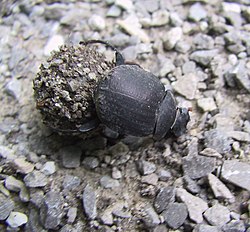| Deltochilum gibbosum | |
|---|---|
 | |
| Scientific classification | |
| Domain: | Eukaryota |
| Kingdom: | Animalia |
| Phylum: | Arthropoda |
| Class: | Insecta |
| Order: | Coleoptera |
| Suborder: | Polyphaga |
| Infraorder: | Scarabaeiformia |
| Family: | Scarabaeidae |
| Genus: | Deltochilum |
| Species: | D. gibbosum |
| Binomial name | |
| Deltochilum gibbosum (Fabricius, 1775) | |
| Synonyms [1] | |
| |
Deltochilum gibbosum, the humpback dung beetle, is a species of dung beetle in the family Scarabaeidae. [1] [2] [3] It is a member of subgenus Hybomidium Shipp, 1897 [4] [5] and is found in the southeastern United States. [5]
Contents

A variety described by Henry Walter Bates in 1887, D. gibbosumvar.sublaeve, has been classified as a separate species D. sublaeve by González-Alvarado and Vaz-de-Mello. [5] The same authors regard D. gibbosumsubsp.panamensisHowden, 1966 as a separate species D. panamensis . [5]